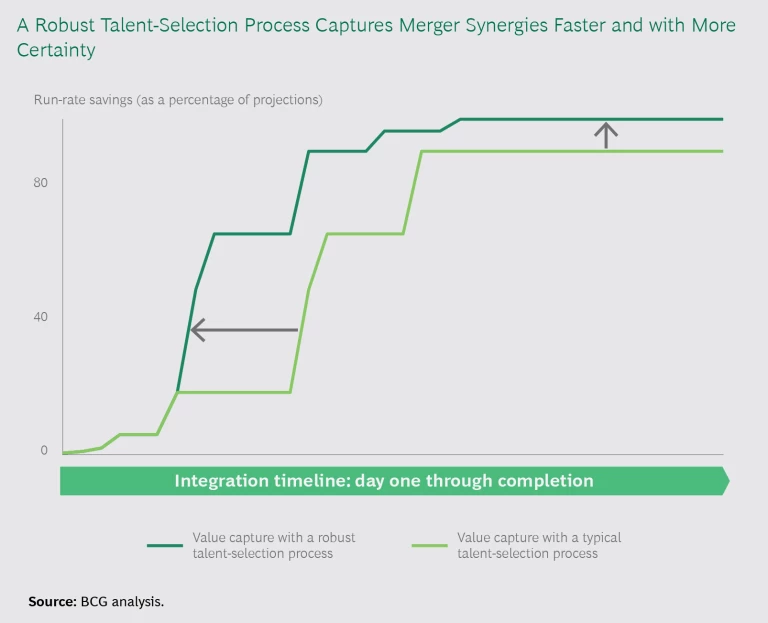When navigating a corporate merger, companies often design only the top one or two layers of the new organization before the deal closes. As a result, after the deal is completed, most of the new organization operates using legacy structures and talent.
Yet BCG’s experience shows that companies are more likely to hit synergy targets, enable strong leadership, and foster accountability if they can implement the new organization design on day one after the merger closes.
To be able to move forward so quickly, BCG recommends first defining the future-state operating model for the merged company and then following a cascade approach in which leaders map out the top four or five layers of the organization design on the basis of operating model needs, guiding principles, and synergy targets.
By developing the organization structure first and subsequently selecting the best talent to fill those layers, companies can avoid the pitfall of designing the organization on the basis of people rather than strategy and principles.
It makes complete sense for companies engaged in a large-scale merger to focus their energies on designing the new organization and operating model. Yet we have seen that many of these companies devote far too little time and energy to selecting the best talent to fill all the boxes in their carefully constructed organization charts.
BCG helps companies bring their new organization structure to life using a fair, robust, and transparent talent-selection process. Our tools and approach enable the new company to capture committed value and achieve long-term strategic goals while minimizing uncertainty for employees.
The Price of Not Proactively Selecting Talent
A merger’s financial projections are based in part on achieving personnel-related efficiencies that will deliver significant cost savings. When companies delay the talent selection process, they postpone the day when they can convert planned benefits into actual bottom-line results. A 2019 BCG analysis of six large mergers indicates that organizations that delay selecting nonexecutive talent for six months risk double-digit percentage savings losses in full-time-equivalent-related value capture.
Perhaps even more critical is that delaying the talent selection process can mean that the new company never achieves its financial projections. Without a process in place, organizations often close deals and move on to other pressing strategic priorities, missing the opportunity to put the talent in place that is necessary to accomplish the goals of the merger.
Delaying the talent selection process can mean that the new company never achieves its financial projections.
Postponing capturing savings or failing to achieve them at all not only can affect the new company’s financial results but also can reduce the board of directors’ enthusiasm for future transactions.
But by proactively selecting talent before a deal closes, companies can capture the anticipated value sooner and increase the run-rate savings realized. (See the exhibit and the sidebar “Matching Talent Selection Principles with Organizational Goals.”)
MATCHING TALENT SELECTION PRINCIPLES WITH ORGANIZATIONAL GOALS
BCG developed design and people principles to guide the talent selection process. The process placed importance on employees’ historical performance, legacy manager conversations, and employee interviews in order to place well-qualified incumbents where they could make the greatest contribution to the new organization.
This principle-driven talent-selection process enabled the new organization to increase diversity by 25% within its top 1,000 positions while maintaining a balance of talent from both legacy organizations. BCG also helped the company identify $200 million in savings on day one from organizational synergies.

Overcoming Talent Selection Hurdles
Matching the best talent with the right roles is no easy task, and it becomes much harder in the midst of a merger. We can help organizations with this effort in three ways.
Navigating Significant Changes to the Operating Model. When two entities merge, they combine operations. Old roles are eliminated, and new roles are created. As a result, many employees may be vying for a limited set of roles, and managers may be competing among themselves to have top talent assigned to their particular unit.
BCG recently helped two large biopharmaceutical companies integrate their organizations and address this issue. The merger led to the creation of a new business unit that had not previously existed in either organization. The companies wanted to make sure that this new unit had the best possible capabilities by staffing it with the most-qualified talent from both legacy organizations.
Working with senior executives from the clients, BCG used its proprietary talent-selection methodology to develop clear guardrails for the talent selection process. Among other things, the guardrails established that current employees would be considered first for open positions and that they would have the opportunity to consider jobs in various locations without relocation restrictions. BCG then codified the companies’ guiding principles on talent selection and the newly developed guardrails into a set of streamlined processes and tools. This allowed the business unit’s leaders to quickly identify talent and submit selection proposals for approval, thus reducing uncertainty for employees and capturing value for the organization.
Bolstering Limited HR Capacity or Experience with Large-Scale Talent Selection. Senior executives often assume that human resources will define and run talent selection processes. But few HR teams have experience dealing with the scale and complexity that’s inherent in the talent selection process for a large merger. In addition, lean HR teams often do not have the capacity to select talent within the ambitious time frame of a typical merger. As a result, HR team members can struggle to balance their business-as-usual activities with the demands of coordinating an intricate talent-selection process involving hundreds or even thousands of employees.
Approaches that use digitization and automation tools have proven equally effective for PMI and organization transformations.
BCG has developed proven approaches to help HR teams overcome challenges associated with large-scale talent-selection initiatives. These approaches, which use digitization and automation tools, have proven equally effective for selecting talent before a deal closes as well as for post-merger integrations , major organization transformations, and large-scale redesigns.
Consider the case of a major Asia-Pacific bank that embarked on a large-scale transformation in pursuit of ambitious cost-efficiency goals. BCG used its proprietary OrgBuilder software and other customized digital tools to help the bank digitize and automate major elements of its talent-selection process.
OrgBuilder and the other online tools that BCG developed allowed leaders to quickly design new positions using abbreviated job descriptions. These tools also gave employees the ability to nominate themselves for open positions and quickly access information about transitioning to another role through a self-service portal. By alleviating the administrative burden typically associated with these tasks, the HR team was able to focus on where it could add the most value: talent allocation and facilitation. As a result, the bank achieved more than $300 million in savings within the first year and established a roadmap to capture $1 billion in savings within three years.
Automation and digitization also dramatically boosted HR efficiency and accuracy. For example, tenure calculation requests that once took two hours to process could now be completed in just ten seconds—with 95% fewer errors.
Making Sense of Global Complexity. When two multinational companies merge, managing the talent selection process requires an intimate understanding of the nuances of international employment law. Every country has its own unique labor laws and regulations that govern employee reassignment, relocation, and release. In addition, many organizations have rules and regulations that apply to various talent pools (employees who are grouped together by region or location). As a result, companies may need to fill certain positions from specific talent pools rather than consider all employees worldwide.
BCG’s global expertise enables us to help HR teams with talent selection processes worldwide. We help HR teams define clear talent-selection principles and processes so that they can comply with local labor requirements while treating all employees with consideration and fairness.
For example, after completing a merger, a multinational company embarked on an effort to collocate key functional activities into several global hubs. As it selected the talent to staff these hubs, the company needed to move employees from approximately two dozen offices around the world. BCG worked alongside the company’s experts and in-country legal counsel to develop relocation plans that complied with local labor laws and works council requirements. BCG reinforced the international talent-selection governance with discrete checks and automated flags to make sure the process would remain compliant while operating at speed. The resulting global talent-selection process was not only logical but also fair and consistent for employees.
Full Speed Ahead
The talent selection process aims to fulfill a merger’s financial expectations while also optimizing the talent of the new organization to drive performance.
Without clear guardrails and processes, talent selection can drag on indefinitely, leading to low morale and attrition.
Without clear guardrails and processes to guide decision making, talent selection can drag on indefinitely or become tangled in bureaucracy, making it hard for companies to implement their future structure, consolidate their talent base, and achieve their goals. Meanwhile, employees suffer from an extended period of uncertainty that can lead to low morale and attrition, robbing the new organization of some of its top talent.
Our approach enables organizations to treat their employees as more than just names in boxes or on spreadsheets. By applying principles, evaluation frameworks, and processes that have been battle-tested in numerous engagements, BCG helps clients implement objective and transparent talent-selection processes that accelerate value creation while ensuring that employees are fairly treated.
BCG’s OrgBuilder then hardwires these principles into a customized, scalable tool. By giving leaders an intuitive interface for designing and staffing teams, OrgBuilder increases the visibility, transparency, and value delivery of the entire talent-selection process.
Talent selection may be complex, but it does not have to be burdensome. By being proactive and leveraging BCG’s experience and proprietary talent-selection methodology and tools, company leaders can unlock the full potential of the new organization.











